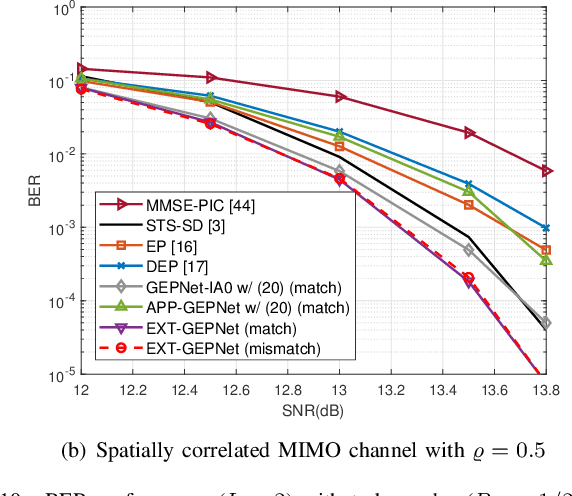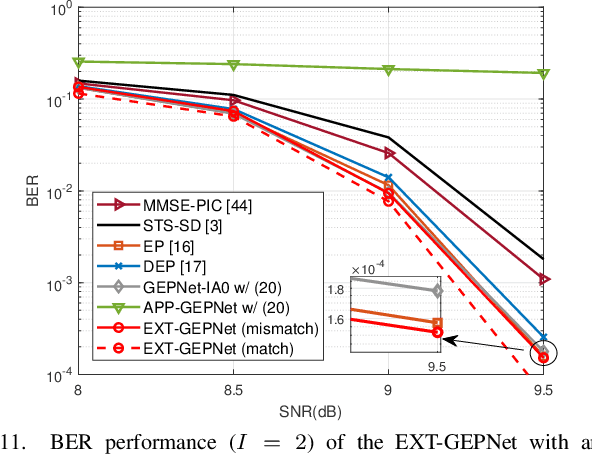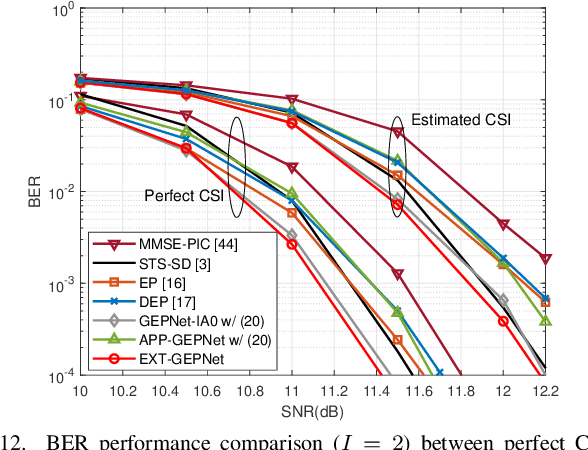Shuangfeng Han
Enhancing Environment Generalizability for Deep Learning-Based CSI Feedback
Jul 09, 2025Abstract:Accurate and low-overhead channel state information (CSI) feedback is essential to boost the capacity of frequency division duplex (FDD) massive multiple-input multiple-output (MIMO) systems. Deep learning-based CSI feedback significantly outperforms conventional approaches. Nevertheless, current deep learning-based CSI feedback algorithms exhibit limited generalizability to unseen environments, which obviously increases the deployment cost. In this paper, we first model the distribution shift of CSI across different environments, which is composed of the distribution shift of multipath structure and a single-path. Then, EG-CsiNet is proposed as a novel CSI feedback learning framework to enhance environment-generalizability. Explicitly, EG-CsiNet comprises the modules of multipath decoupling and fine-grained alignment, which can address the distribution shift of multipath structure and a single path. Based on extensive simulations, the proposed EG-CsiNet can robustly enhance the generalizability in unseen environments compared to the state-of-the-art, especially in challenging conditions with a single source environment.
Generalizable Learning for Frequency-Domain Channel Extrapolation under Distribution Shift
May 20, 2025Abstract:Frequency-domain channel extrapolation is effective in reducing pilot overhead for massive multiple-input multiple-output (MIMO) systems. Recently, Deep learning (DL) based channel extrapolator has become a promising candidate for modeling complex frequency-domain dependency. Nevertheless, current DL extrapolators fail to operate in unseen environments under distribution shift, which poses challenges for large-scale deployment. In this paper, environment generalizable learning for channel extrapolation is achieved by realizing distribution alignment from a physics perspective. Firstly, the distribution shift of wireless channels is rigorously analyzed, which comprises the distribution shift of multipath structure and single-path response. Secondly, a physics-based progressive distribution alignment strategy is proposed to address the distribution shift, which includes successive path-oriented design and path alignment. Path-oriented DL extrapolator decomposes multipath channel extrapolation into parallel extrapolations of the extracted path, which can mitigate the distribution shift of multipath structure. Path alignment is proposed to address the distribution shift of single-path response in path-oriented DL extrapolators, which eventually enables generalizable learning for channel extrapolation. In the simulation, distinct wireless environments are generated using the precise ray-tracing tool. Based on extensive evaluations, the proposed path-oriented DL extrapolator with path alignment can reduce extrapolation error by more than 6 dB in unseen environments compared to the state-of-the-arts.
AI-driven 6G Air Interface: Technical Usage Scenarios and Balanced Design Methodology
Mar 16, 2025Abstract:This paper systematically analyzes the typical application scenarios and key technical challenges of AI in 6G air interface transmission, covering important areas such as performance enhancement of single functional modules, joint optimization of multiple functional modules, and low-complexity solutions to complex mathematical problems. Innovatively, a three-dimensional joint optimization design criterion is proposed, which comprehensively considers AI capability, quality, and cost. By maximizing the ratio of multi-scenario communication capability to comprehensive cost, a triangular equilibrium is achieved, effectively addressing the lack of consideration for quality and cost dimensions in existing design criteria. The effectiveness of the proposed method is validated through multiple design examples, and the technical pathways and challenges for air interface AI standardization are thoroughly discussed. This provides significant references for the theoretical research and engineering practice of 6G air interface AI technology.
Path Evolution Model for Endogenous Channel Digital Twin towards 6G Wireless Networks
Jan 25, 2025



Abstract:Massive Multiple Input Multiple Output (MIMO) is critical for boosting 6G wireless network capacity. Nevertheless, high dimensional Channel State Information (CSI) acquisition becomes the bottleneck of 6G massive MIMO system. Recently, Channel Digital Twin (CDT), which replicates physical entities in wireless channels, has been proposed, providing site-specific prior knowledge for CSI acquisition. However, external devices (e.g., cameras and GPS devices) cannot always be integrated into existing communication systems, nor are they universally available across all scenarios. Moreover, the trained CDT model cannot be directly applied in new environments, which lacks environmental generalizability. To this end, Path Evolution Model (PEM) is proposed as an alternative CDT to reflect physical path evolutions from consecutive channel measurements. Compared to existing CDTs, PEM demonstrates virtues of full endogeneity, self-sustainability and environmental generalizability. Firstly, PEM only requires existing channel measurements, which is free of other hardware devices and can be readily deployed. Secondly, self-sustaining maintenance of PEM can be achieved in dynamic channel by progressive updates. Thirdly, environmental generalizability can greatly reduce deployment costs in dynamic environments. To facilitate the implementation of PEM, an intelligent and light-weighted operation framework is firstly designed. Then, the environmental generalizability of PEM is rigorously analyzed. Next, efficient learning approaches are proposed to reduce the amount of training data practically. Extensive simulation results reveal that PEM can simultaneously achieve high-precision and low-overhead CSI acquisition, which can serve as a fundamental CDT for 6G wireless networks.
Energy Optimization of Multi-task DNN Inference in MEC-assisted XR Devices: A Lyapunov-Guided Reinforcement Learning Approach
Jan 05, 2025



Abstract:Extended reality (XR), blending virtual and real worlds, is a key application of future networks. While AI advancements enhance XR capabilities, they also impose significant computational and energy challenges on lightweight XR devices. In this paper, we developed a distributed queue model for multi-task DNN inference, addressing issues of resource competition and queue coupling. In response to the challenges posed by the high energy consumption and limited resources of XR devices, we designed a dual time-scale joint optimization strategy for model partitioning and resource allocation, formulated as a bi-level optimization problem. This strategy aims to minimize the total energy consumption of XR devices while ensuring queue stability and adhering to computational and communication resource constraints. To tackle this problem, we devised a Lyapunov-guided Proximal Policy Optimization algorithm, named LyaPPO. Numerical results demonstrate that the LyaPPO algorithm outperforms the baselines, achieving energy conservation of 24.79% to 46.14% under varying resource capacities. Specifically, the proposed algorithm reduces the energy consumption of XR devices by 24.29% to 56.62% compared to baseline algorithms.
Channel Modeling Aided Dataset Generation for AI-Enabled CSI Feedback: Advances, Challenges, and Solutions
Jul 01, 2024



Abstract:The AI-enabled autoencoder has demonstrated great potential in channel state information (CSI) feedback in frequency division duplex (FDD) multiple input multiple output (MIMO) systems. However, this method completely changes the existing feedback strategies, making it impractical to deploy in recent years. To address this issue, this paper proposes a channel modeling aided data augmentation method based on a limited number of field channel data. Specifically, the user equipment (UE) extracts the primary stochastic parameters of the field channel data and transmits them to the base station (BS). The BS then updates the typical TR 38.901 model parameters with the extracted parameters. In this way, the updated channel model is used to generate the dataset. This strategy comprehensively considers the dataset collection, model generalization, model monitoring, and so on. Simulations verify that our proposed strategy can significantly improve performance compared to the benchmarks.
Low-Complexity Joint Beamforming for RIS-Assisted MU-MISO Systems Based on Model-Driven Deep Learning
Nov 26, 2023Abstract:Reconfigurable intelligent surfaces (RIS) can improve signal propagation environments by adjusting the phase of the incident signal. However, optimizing the phase shifts jointly with the beamforming vector at the access point is challenging due to the non-convex objective function and constraints. In this study, we propose an algorithm based on weighted minimum mean square error optimization and power iteration to maximize the weighted sum rate (WSR) of a RIS-assisted downlink multi-user multiple-input single-output system. To further improve performance, a model-driven deep learning (DL) approach is designed, where trainable variables and graph neural networks are introduced to accelerate the convergence of the proposed algorithm. We also extend the proposed method to include beamforming with imperfect channel state information and derive a two-timescale stochastic optimization algorithm. Simulation results show that the proposed algorithm outperforms state-of-the-art algorithms in terms of complexity and WSR. Specifically, the model-driven DL approach has a runtime that is approximately 3% of the state-of-the-art algorithm to achieve the same performance. Additionally, the proposed algorithm with 2-bit phase shifters outperforms the compared algorithm with continuous phase shift.
Graph Neural Network-Enhanced Expectation Propagation Algorithm for MIMO Turbo Receivers
Aug 22, 2023



Abstract:Deep neural networks (NNs) are considered a powerful tool for balancing the performance and complexity of multiple-input multiple-output (MIMO) receivers due to their accurate feature extraction, high parallelism, and excellent inference ability. Graph NNs (GNNs) have recently demonstrated outstanding capability in learning enhanced message passing rules and have shown success in overcoming the drawback of inaccurate Gaussian approximation of expectation propagation (EP)-based MIMO detectors. However, the application of the GNN-enhanced EP detector to MIMO turbo receivers is underexplored and non-trivial due to the requirement of extrinsic information for iterative processing. This paper proposes a GNN-enhanced EP algorithm for MIMO turbo receivers, which realizes the turbo principle of generating extrinsic information from the MIMO detector through a specially designed training procedure. Additionally, an edge pruning strategy is designed to eliminate redundant connections in the original fully connected model of the GNN utilizing the correlation information inherently from the EP algorithm. Edge pruning reduces the computational cost dramatically and enables the network to focus more attention on the weights that are vital for performance. Simulation results and complexity analysis indicate that the proposed MIMO turbo receiver outperforms the EP turbo approaches by over 1 dB at the bit error rate of $10^{-5}$, exhibits performance equivalent to state-of-the-art receivers with 2.5 times shorter running time, and adapts to various scenarios.
Deterministic End-to-End Transmission to Optimize the Network Efficiency and Quality of Service: A Paradigm Shift in 6G
Jul 02, 2023

Abstract:Toward end-to-end mobile service provision with optimized network efficiency and quality of service, tremendous efforts have been devoted in upgrading mobile applications, transport and internet networks, and wireless communication networks for many years. However, the inherent loose coordination between different layers in the end-to-end communication networks leads to unreliable data transmission with uncontrollable packet delay and packet error rate, and a terrible waste of network resources incurred for data re-transmission. In an attempt to shed some lights on how to tackle these challenges, design methodologies and some solutions for deterministic end-to-end transmission for 6G and beyond are presented, which will bring a paradigm shift to the end-to-end wireless communication networks.
Network Architecture Design toward Convergence of Mobile Applications and Networks
Jun 15, 2023Abstract:With the quick proliferation of extended reality (XR) services, the mobile communications networks are faced with gigantic challenges to meet the diversified and challenging service requirements. A tight coordination or even convergence of applications and mobile networks is highly motivated. In this paper, a multi-domain (e.g. application layer, transport layer, the core network, radio access network, user equipment) coordination scheme is first proposed, which facilitates a tight coordination between applications and networks based on the current 5G networks. Toward the convergence of applications and networks, a network architectures with cross-domain joint processing capability is further proposed for 6G mobile communications and beyond. Both designs are able to provide more accurate information of the quality of experience (QoE) and quality of service (QoS), thus paving the path for the joint optimization of applications and networks. The benefits of the QoE assisted scheduling are further investigated via simulations. A new QoE-oriented fairness metric is further proposed, which is capable of ensuring better fairness when different services are scheduled. Future research directions and their standardization impacts are also identified. Toward optimized end-to-end service provision, the paradigm shift from loosely coupled to converged design of applications and wireless communication networks is indispensable.
 Add to Chrome
Add to Chrome Add to Firefox
Add to Firefox Add to Edge
Add to Edge